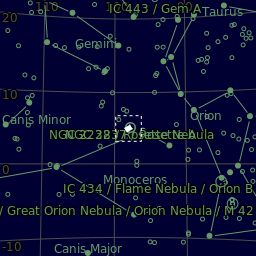Satellite Cluster
- Pierre Moutounet-Cartan
- Mar 1
- 1 min read
About this object
NGC 2244, also known as Caldwell 50 or the Satellite Cluster, is a breathtaking open cluster nestled within the Rosette Nebula in the constellation Monoceros. This young and dynamic cluster, estimated to be less than 5 million years old, is a hotbed of stellar activity, home to several massive O-type stars that dominate its landscape. These stars, including HD 46223 (O4V) and HD 46150 (O5V), are incredibly luminous—up to 450,000 times brighter than the Sun—and exert tremendous radiation and stellar winds, shaping the surrounding nebula. The cluster’s brightest star in the line of sight is 12 Monocerotis, a foreground K-class giant, though it is not a true member of NGC 2244. Recent studies have revealed fascinating details about this cluster, including the discovery that brown dwarfs tend to form closer to the massive OB stars than to other stars, likely due to the photoevaporation of prestellar cores by intense radiation. Additionally, the disk fraction for low-mass objects in NGC 2244 is relatively low (39%±9% for objects later than K0), and one member even shows signs of an eroding disk, reminiscent of a proplyd. For amateur astronomers, NGC 2244 is a stunning target, offering a glimpse into the early stages of star formation and the dramatic interplay between young stars and their environment. Whether viewed through a telescope or captured in astrophotography, this cluster and its surrounding nebula are a true celestial spectacle.
Designations
Standardized Catalogues
PMC Observatory Catalogue
Observations
2025-02-25 at around 10:00 pm (+00:00)






